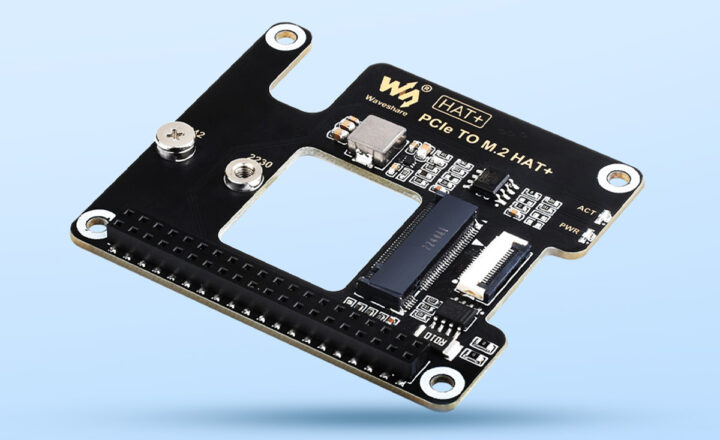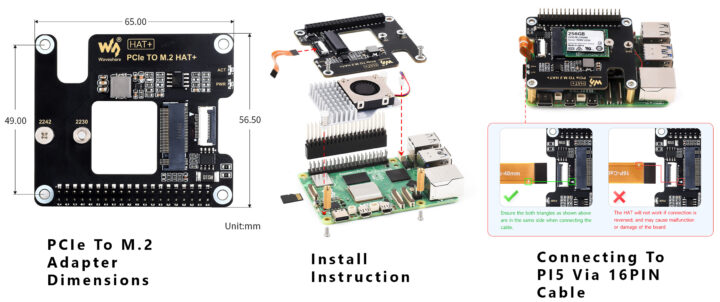The Waveshare PCIe To M.2 adapter is an inexpensive PCIe to M.2 HAT+ module for the Raspberry Pi 5 designed for PCIe Gen2 and Gen3 SSDs. It is compatible with standard SSD sizes of 2230/2242 and features status indicator LEDs, a power monitoring chip, an EEPROM, and a cooling fan vent to keep temperatures in control during heavy use.
It’s not the first Raspberry Pi 5 adapter taking NVMe SSDs (or AI accelerator), as we previously explored the PineBerry Pi’s HatDrive, suitable for 2230, 2242, and 2280 SSDs up to PCIe Gen3 speeds and the Pimoroni NVMe Base with a different design and compatible with 2230, 2242, 2260, and 2280 drives up to PCIe Gen3 speeds. A few days ago, we already covered Waveshare’s PoE HAT(F), which shares a similar form factor with Waveshare PCIe To M.2 Adapter and uses the new HAT+ standard to provide 24W of power to the Raspberry Pi 5.
Waveshare PCIe To M.2 Adapter specifications:
- Compatibility:
- Designed specifically for Raspberry Pi 5 SBC
- Supports HAT+ Standard
- M.2 SSD Interface:
- Compatible with M.2 Solid State Drives (sizes 2230/2242).
- Supports both PCIe Gen2 and Gen3 modes.
- Enables Raspberry Pi 5 to boot directly from SSD.
- Design and Build:
- Compact form factor.
- Incorporates airflow vent for a cooling fan.
- Includes status indicator LEDs for power and Read/Write operations.
- Equipped with EEPROM for HAT ID and product information storage.
- Features a power monitoring chip for SSD power status.
- Package Contents:
- PCIe To M.2 HAT.
- Double-row 20-pin header.
- 16-pin cable (40mm length).
- Set of standoffs for mounting.
- Dimensions – 65.00 x 56.50 mm
The product page provides dimensions, installation instructions, board parts markings, and many other useful insights about the product. However, for those who want to start working with this product, you can find a guide and plenty of instructions on the Wiki page.
The Waveshare PCIe To M.2 Adapter is available for purchase on several online platforms. It is priced at $15.29 with shipping on Aliexpress. Additionally, you can find it on the company’s online store, where it is listed for $8.99, excluding shipping costs.
Debashis Das is a technical content writer and embedded engineer with over five years of experience in the industry. With expertise in Embedded C, PCB Design, and SEO optimization, he effectively blends difficult technical topics with clear communication
Support CNX Software! Donate via cryptocurrencies, become a Patron on Patreon, or purchase goods on Amazon or Aliexpress






